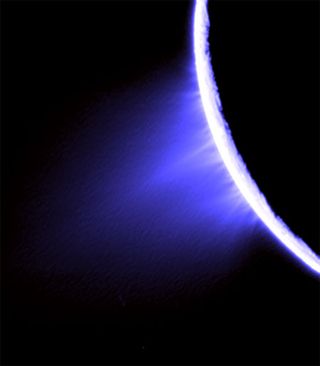Scientists Mark Cassini Saturn Probe's 10th Anniversary

More than 1,400 scientists gathered last week to mark the 10thanniversary of the launch of the Cassini-Huygens spacecraft to Saturn anddiscuss the mission?s latest discoveries.
Since liftoff on Oct. 15, 1997, aboard a U.S. Air ForceTitan 4B rocket, the mission's scientific instruments powered by radioisotope thermoelectric generatorshave captured a great deal of new information about Saturn?srings and moons.
"With Cassini, amazing discoveries have almost becomeroutine," said Cassini project scientist Dennis Matson of NASA's JetPropulsion Laboratory, who manages Cassini?s science activities.
Those discoveries include ice geysers shooting from Saturn's moonEnceladus and finding that one of Saturn?s rings is created from such ice particles.Cassini will get an even closer look in March 2008 when its third flyby of themoon takes itdirectly into an icy polar geyser. Scientists want to confirm theirsuspicions that the geyser is 90 percent water-ice crystals. Ammonia andmethane gas are probably also present there, Matson said.
The Cassiniorbiter deployed the European Space Agency?s (ESA) Huygensprobe which parachuted down to the frozen surface of Titan – a moon with lakesof hydrocarbons and complex chemistry that includes methanedrizzles – on Jan. 14, 2005. Scientists around the world are recreatingconditions on Titan?s surface by using information sent back by Huygens.Cassini has also used an onboard radar instrument to peer through the thickclouds of Titan.
?For all of us so closely involved in discovering anEarth-like world, it was worth the long trip. We are now learning aboutterrestrial-processes that take place on another world – which is fascinating.Cassini-Huygens is truly a success story in international cooperation,? said Jean-PierreLebreton, ESA Huygens project scientist.
Saturn is stillshrouded in mysteries, but Cassini continues to deliver data well beyondits mission life of four years.
Get the Space.com Newsletter
Breaking space news, the latest updates on rocket launches, skywatching events and more!
- VIDEO: Cassini's Saturn Ring Crossing
- Special Report: Cassini's Ongoing Mission to Saturn
- VOTE NOW! Cassini's Greatest Hits at Saturn
Join our Space Forums to keep talking space on the latest missions, night sky and more! And if you have a news tip, correction or comment, let us know at: community@space.com.
Jeremy Hsu is science writer based in New York City whose work has appeared in Scientific American, Discovery Magazine, Backchannel, Wired.com and IEEE Spectrum, among others. He joined the Space.com and Live Science teams in 2010 as a Senior Writer and is currently the Editor-in-Chief of Indicate Media. Jeremy studied history and sociology of science at the University of Pennsylvania, and earned a master's degree in journalism from the NYU Science, Health and Environmental Reporting Program. You can find Jeremy's latest project on Twitter.
